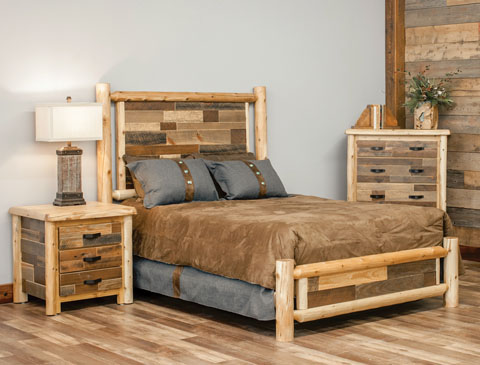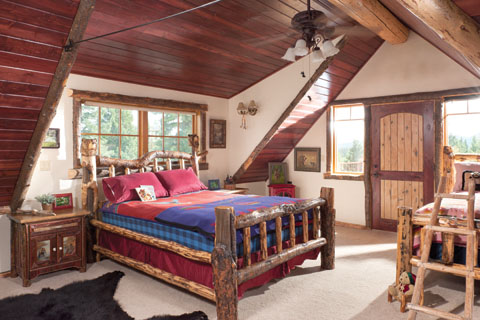If you would like to get back to your roots when furnishing your log or timber home, rustic furniture is the way to go. Typically wooden and distressed looking, rustic furniture can invite a sense of simplicity and old-fashioned charm.
“Rustic décor seems to relax people,” says Shirley Brown, owner of Papa Bear’s Northwoods Store in Baraboo, Wisconsin. “They feel like they’re in the great outdoors.”
Rustic, by definition, is untamed. Furniture pieces look “lived in,” and chipped paint is a good thing. While mass-produced furniture pieces are cut and sanded to look alike, rustic furniture pieces are one of a kind. Nature is the chief designer. Builders showcase the growth and weather patterns from individual trees, turning beds, tables, and dressers into works of art.
When choosing furniture, think of the ambiance you wish to create. Do you want to highlight a passion for hunting or fishing? Do you want to portray an early 20th-century farm house? Do you want to combine rustic pieces with a contemporary style? With so many decorating styles available, you’re bound to find one you like.
.jpg)
Papa Bear’s Northwoods Store
Regardless of your end goal, it’s important to use natural wooden pieces for your overall design. Some woods, like juniper and aspen, display a natural beauty created by weather and insect patterns. Pine and white cedar are less expensive woods, while black walnut, cherry, and aspen are more costly, Brown says. Some homeowners like the contrast of dark and light woods combined.
For a plainer approach to furnishing, consider buying pieces made from old barnwood or warehouse beams. Wood is often selected from barns that are more than 100 years old. Types of wood vary depending on what individual farmers used to construct the barns. “Every piece of this wood has a history,” says Jason Hunt, marketing director of Woodland Creek Furniture in Traverse City, Michigan.
Although recycled wood décor is usually more expensive than traditional log furniture, it has a beauty of its own. Some builders combine wood from several different barns to make tables with various colors.
If you don’t want to go too rustic, you could look at contemporary rustic furniture, where builders combine thick organic slabs of wood with modern bases.
Once you have purchased your basic décor, you can personalize each room with additional flare. Nothing says conversation piece more than a unique coffee table or end table. If you really want to get back to nature, you can purchase tables with antlers at the base. You could also buy a table with a copper finish. Natural, pure copper is corrosion resistant, making it long lasting and easy to clean.

Woodland Creek Furniture
Nature’s craftsmanship is especially observed in birch bark and burl wood furniture. Rustic furniture builders use birch bark to make intricate designs, particularly for panels in tables and cabinets.
A burl is a tree growth, usually found on the trunk. It is caused by some kind of stress, such as injury, virus or mold growth. The wood harvested from burls has rare designs that work nicely for tabletops.
When choosing upholstered furniture, think about contrast. Colorful upholstery can brighten your room, while soft organic tones blend in. Animal designs and Native American designs bring in the outdoors. Plaids take you back to the forest.
It’s important to consider durability and weather resistance when choosing outdoor furniture. Both Northern white and Western red cedar contain natural oils that repel weather quite well. Teak is also weather repellant. Concrete, because of its density, is popular for outdoor table tops. No matter what you choose, your outdoor furniture will last longer if you store it indoors during the winter.

Papa Bear’s Northwoods Store
Since rustic décor celebrates age, feel free to salvage end tables and hutches from thrift or antique stores. These later additions can tie the details of each room together. It feels pretty rewarding when you do some of the work yourself. It can also save you money.
Jolynn Barron of Klamath Falls, Oregon, has built a word-of-mouth furniture painting business by buying used pieces and refinishing them. She has refinished more than 500 pieces. She suggests looking for pieces at thrift stores that are from the 1960s or earlier. Furniture from the 1970s and 1980s often has a veneer or lacquer finish, which is challenging to remove.
When Barron restains wood, she starts by removing any handles and sanding each piece thoroughly. She uses a cheese cloth or an old t-shirt to gently rub in the stain and remove any excess.
When painting, Barron uses chalk paint or Krylon flat paint. Spraying paint in an even, back-and-forth motion is preferable to using paintbrushes, she says, because it’s easier to avoid drips. After the paint is dry, she uses a fine grain sandpaper to lightly touch on areas that would naturally become worn, such as table edges and chair seats. As you may have guessed, not all rustic furniture is created equal. If you purchase higher quality, it is sure to last a lifetime. While ordering online may seem more convenient, visiting showrooms in person allows you to hand pick your furniture. You can literally get a feel for what you want.

Woodland Creek Furniture
Hunt advises potential customers to look for companies that have been in business for several years. Look for good customer reviews and longer product warranties, he says.
“A good deal isn’t just price. A good deal is a quality product at a great price.”
“All logs are going to check [crack] to some degree,” he adds. Sometimes small shops don’t have a way to dry out the logs and lumber, so they build their beds with green, or wet, logs. When the wood dries after the furniture is built, it’s likely for cracks to appear in structural areas.
A wise builder will dry the wood properly before building. When checking appears, they build the furniture around the checking. Checking doesn’t damage log furniture as long as it is built properly, Hunt says.
Finding the perfect rustic furniture may seem daunting, but by following these suggestions, you can successfully acquire pieces that complement your style and last for a lifetime.

